 Leading Blog | Posts by Month |
 Leading Blog | Posts by Month |
08.31.18

LeadershipNow 140: August 2018 Compilation
See more on
Posted by Michael McKinney at 12:03 AM
08.29.18

Getting Real About the Monsters Under the Bed
Some windows are lighted. But mostly they're darked. I once had a conversation with a neighbor who admitted, matter-of-factly, that she really doesn’t like change. This preference shapes her decisions, and her life, in countless ways. Now, I can intellectualize a desire to hold on to the status quo. But I don’t really get it. No matter how good things are, our lives can always be better. So why not strive for more: in our work, our relationships, our families, our communities? Not to be greedy, but to live life to its fullest, and to make our world a little better. Ultimately, I suspect the fear of change is really a fear of uncertainty. A nagging sense that the benefits of change might not justify the potential risks. Shakespeare describes this human condition well, as he so often does: “Our doubts are traitors/And make us lose the good we oft might win/By fearing to attempt.” [Measure for Measure, I:4]
The political discourse of late has become fixated on certainty, and it’s discouraging. “The problem is with the Mexicans, or the Muslims, or the banks, or the police, or the pharmaceutical companies.” We know in our hearts that simple, certain solutions are both incomplete and intellectually dishonest: “If we make these changes, then the monsters won’t hide under the [proverbial] bed.” Certainty may get votes, but it isn’t leadership. We aren’t children. Where is the courage—on either side of the political aisle—to admit that the world is complex? That we rarely understand the relationship between cause and effect? Klaus Schwab of the World Economic Forum wrote an excellent book, The Fourth Industrial Revolution, which should be required reading for all business and political leaders. Not because it paints a clear picture of the future. Rather, because it so clearly describes an amazing, uncertain future, full of both opportunity and peril. And because it raises critical questions that aren’t getting nearly enough attention—in the halls of Congress or the conference rooms of corporate America. As Schwab argued: “The fourth industrial revolution is not only changing what we do but also who we are. The impact it will have on us as individuals is manifold, affecting our identity and its many related facets – our sense of privacy, our notions of ownership, our consumption patterns, the time we devote to work and leisure, how we develop our careers, cultivate our skills. It will influence how we meet people and nurture relationships, the hierarchies upon which we depend, our health, and maybe sooner than we think, it could lead to forms of human augmentation that cause us to question the very nature of human existence. Such changes elicit excitement and fear as we move at unprecedented speed.” Surely, we all need to get more comfortable with ambiguity. We can scarcely understand the present, and we have yet to invent a crystal ball that sees into the future. Change is scary, but so is standing still. As Bono sang in U2’s (underrated) song, Summer Rain: “When you stop taking chances you'll stay where you sit/You won't live any longer but it'll feel like it.” I have bad news for my neighbor. Change is not just coming; it’s already here. And it’s going to accelerate. More than ever, corporate and political leaders need to get real. They need to acknowledge complexity, work together to confront difficult questions, and offer an honest, thoughtful assessment of risks and opportunities as they chart a path into an uncertain future. 
Posted by Michael McKinney at 07:30 AM
08.27.18

Is a Lack of Awareness Holding You Back?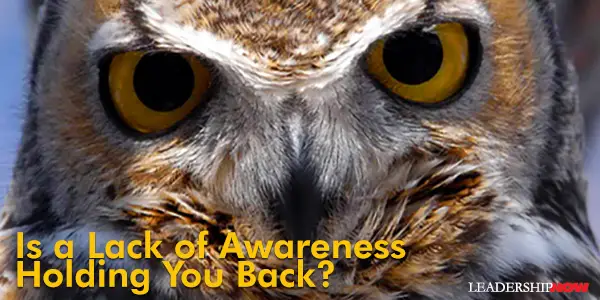
A Bob Rosen and Emma-Kate Swann wrote Conscious: The Power of Awareness in Business and Life, because they believe that becoming more conscious is critical in our increasingly disruptive and accelerating world. “Most of us believe they are self-aware, but research shows that only 10 to 15% of us truly have this capability.” “The real power of awareness is found when we master action and introspection together” or what they refer to as conscious. “Lifting your gaze outside yourself while looking inward to remove the roots of resistance is how you become more conscious.” Being the smartest person in the room is not the advantage it might have been because it gets in the way of adapting to the change happening all around us. “Conscious is the new smart.” Driven by the need to be right, those obsessed with being smart tend to hoard knowledge, externalize blame, and mismanage relationships and risks. This sabotages our ability to thrive in a constantly changing world. There are four reasons why we are not aware as we need to be: 1. Too Shallow: “We spend little time self-reflecting and stay stuck in negative emotions, shackled by old baggage, resulting in little understanding of ourselves.” We just don’t dig deep enough. 2. Too Narrow: “We don’t challenge our outdated assumptions, which limits the power of our expansive minds.” With limited perspectives we miss opportunities and react irrationally. 3. Too Safe: “We are afraid of change and prefer to avoid the uncertainty around us. As a result, we stay stuck, biased, and reactive.” 4. Too Small: “If your view of yourself and the world is too small, you won’t see connections, possibilities, or solutions. Staying small and never stepping up is sure to lead to regrets and will undermine your highest potential.” The antidote to our lack of self-awareness is: Go Deep Harness the power of introspection by getting to know who you are, where you come from, and why you act the way you do. Think Big Get curious and adaptive: deal with complexity and paradox by learning how to expand your mind, leverage your relationships and networks, and overcome unconscious biases. Get Real Become more honest and intentional in leadership and life, overcoming the pitfalls of being too safe and cautious while embracing reality. Step Up Act boldly and responsibly to reach your highest potential: how to champion your higher purpose, stretch people in constructive ways, and be generous in your relationships. 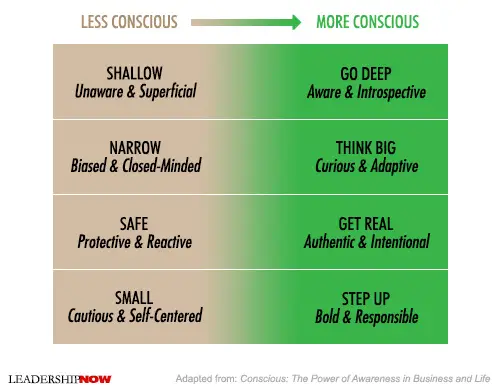 To address the realities of our time, we need people who will Go Deep, Think Big, Get Real, and Step Up. To lead change you need a conscious mindset. “Regardless of the context or the reason for change, leaders at all levels must lead people into the unknown and into the future.” If we are going to create change, we have to begin with ourselves. That requires that we become more conscious of what pushes us forward—our Accelerators—and what holds us back—our Hijackers. Accelerators like courage, drive or determination, deliberate practice, resilience, and vulnerability, drive us forward. Hijackers like self-criticism, cynicism, controlling behavior, aloofness or disengagement, and hyper-competitiveness, hold us back. It is important to know how these things impact your performance and constructively use them or deal with them. There are many things that conspire to throw us off-course. Knowing who you want to be in the world and remembering your purpose, will help you to manage these issues and keep you on course. The more conscious we are the less drama we will experience in our lives. Another consequence of being conscious is to be civil. People and events will push our buttons, but the mature, conscious person will know when to “reprioritize personal needs and self-interests” for the good of all. “Conscious people realize there is a human being on the other end of every connection. Acts of civility are the small sacrifices we make for the good of all and the sake of harmoniously living and working together.” A good example of that kind of self-control and consciousness is John McCain’s comment to a woman at a town hall meeting that said she didn't trust then-Sen. Barack Obama because "he's an Arab." McCain responded, “No, ma'am. He's a decent, family man, citizen that I just happen to have disagreements with on fundamental issues.” Conscious people see the big picture and know what is important. Consciousness is a choice. Conscious unleashes our full potential as human beings. By expanding our minds, enriching our experiences, and shaping our destinies, we discover our purpose in life. Being conscious enables us to approach life as a journey. Equipped with everything we need—an open mind and heart, confidence and resilience, and our capacity for greater consciousness—we embrace the uncertainty of life. Conscious is the accelerator for effective change. The more conscious we are, the faster we adapt, and the higher performing we become. 
Posted by Michael McKinney at 07:32 AM
08.24.18

Engagement Isn’t Built, It’s Uncovered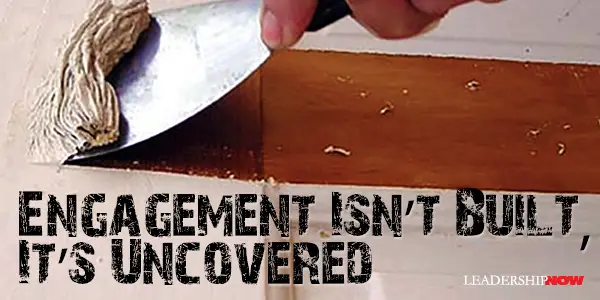
W But over the years, depending on our upbringing, our schooling, and our work, our desire to engage gets suppressed. It gets covered up. Our job as leaders is to uncover and rekindle that child-like desire to engage with others and our environment. We can’t create engagement, but we can uncover it. I was reading a remarkable little book written for teachers by retired professor Calvin Luther Martin entitled, Successful College Teaching Begins with Throwing Away Your Lecture Notes. We can learn a lot here because teaching, like leading, is about serving others while achieving a result. Indeed, teaching is a function of leading. We teach much more than our subject matter; we teach trust or distrust, courtesy or discourtesy, warmth or coldness—the lessons between the lines. The people we lead are not coming to us from our perspective. They have their own that has been years on the making. Bear in mind that you are teaching young men and women with an educational past that has shaped them. We bring our whole selves to work. Our hope, our scars, our dreams, our fears, our expectations, and our assumptions. Our childhood sense of wonder has been abused. It’s there, but it is cautious. We are conditioned to want to be right more than we want to be accurate. Behold the class before you. They are not blank slates, nor are they ignorant. There is plenty written on those slates and your task is to rewrite much of that text—if they will trust you and if your good enough to get that close to them. They sit before you, thoroughly trained (brainwashed might be a better word) in ways of pedagogy that will determine how they hear you, what they hear and cannot hear, and how they will absorb what you say. We are not leading another version of us. We are leading a human being similar in form but different in substance. These people come to you with layers of expectations that have been created starting in the first grade. Like an old kitchen countertop, they have been painted over and over. The oak, cherry, or maple cabinet beneath is smothered by an amour of paint. It’s a bland countertop now. The fine wood underneath is unknown; it’s merely a rigid structure useful for covering with paint and, after that, supporting pots and pans. A leader has to peel off the old paint and get to that desire to engage that has been unwittingly covered over. We have to uncover the desire to engage. The desire to learn. The desire to connect. The tendency is to be instructing. We do need to instruct but it needs to be part of a larger, coherent story that people can feel a part of. We are wired to engage. It’s already within us. Our task as leaders is to uncover what is already there. Martin explains that to teach or to lead “is to give a concert, to perform a beautiful, passionate concerto which everyone in the audience yearns to play, improvise on, and even improve.” We don’t build engagement, we uncover it. Uncover engagement in your organization. 
Posted by Michael McKinney at 07:01 AM
08.22.18

7 Tips for Overcoming Imposter Syndrome
I Not only do you grow from the experience, but you’ll have a roomful of experts to learn from. At first, you may feel inadequate—feel like an imposter—but with enough grit, you’ll succeed and move forward. When you feel like you don’t belong—like you are not up to par—know that it is a side effect of growth that everyone experiences at one time—or many times—throughout a career. If you are a high performer, it comes with the territory. You are doing the hard things. And that’s a good thing. You are, as Laura Otting puts it, “Standing on the edge of our incompetence.” Think of imposter syndrome as valuable feedback that you are growing and are outside your comfort zone. Self-doubt comes before growth. Contrary to all appearances, imposter syndrome is experienced by very successful people. Barbara Corcoran, an entrepreneur and longtime investor on ABC’s Shark Tank, said at Fiverr’s Bridge the Gap webinar, “The more successful someone is, the more self-doubt they have because that’s what drives them. I’ve never met a secure person who was a stellar star. I look for a [competitor] who’s mostly insecure because I know I’ve got myself a winner. They have the ambition. They’re going to work twice as hard, which, I think, is the great upside to feeling like you’re an impostor.” Graham offers 7 tips for overcoming Imposer Syndrome: 1. If You Aren’t Struggling a Bit, You Aren’t Growing Much “When you’re taking on a new venture like a job switch, it’s normal to feel behind the curve. This doesn’t mean you’re a fraud or not cut out for the work. Don’t compare your start to someone else’s peak.” 2. Quite that Inner Voice “We are often our own worst critic and hardest on ourselves. If you’re new at something, have realistic expectations and give yourself the latitude to learn.” 3. Perfection is Slow Death “Perfectionists have an all-or-nothing view. Even as a seasoned expert, you’re human and not immune to bad days or learning curves. Mistakes can indicate that you need to prioritize, delegate, or take a break. Or they could just be mistakes. Don’t make them into more than they are.” 4. Honor Your Accomplishments “Life isn’t about keeping a scorecard. Reminisce about past successes, and then engage strategies that worked before to tackle the problems you’re facing.” 5. Drop the “Yes, but….” “Do you deflect or write off compliments? Perhaps you attribute your success to luck. We are masters at believing negative feedback while shrugging off the positive. Take time to listen to praise from others and own it.” 6. Plan for the Worst-Case Scenario “The worst-case scenario rarely happens, but if you have an action plan should it become a reality, you can be confident you’ll handle the lesser obstacles that do arise.” 7. Fake It ‘til You Make It “When you come across as self-assured, others sense that it creates a positive spiral. Self-assurance doesn’t mean you have all of the answers, rather that you’re confident you can use resources to find solutions as problems arise.” And here’s a fact of life. The more you learn about something, the more you’ll realize how little you know about the topic in terms of all there is to know. Stay humble and curious. It will give you unprecedented depth in this day and age. At the same time, imposter syndrome isn’t all that bad, thanks to the Dunning-Kruger effect that observes that the most incompetent are often the most confident because they don’t know enough to know that they are, in fact, incompetent. The sense that you don’t know everything can give you an edge because your imposter syndrome can motivate you to work hard and learn more. Beyond what I'm sharing here, Switchers is an invaluable resource for those looking to make a career switch. “If you’re like most Americans, you’ll spend around five years of your life engaged in some type of job search activity.” Today though, people aren’t just changing jobs. They’re changing professions. And this requires a different approach than the typical job search. Graham writes from a recruiter’s point of view, sharing not only what they think but also the psychological principles that underlie the Switcher’s journey. She covers the five job search killers, networking and the 2nd Level Contact Strategy, rebranding your social media profile, and crafting your professional identity. Bias is a reality in the hiring process and can be an especially difficult hurdle for Switchers. Learn to identify it and engage strategies to overcome it, such as using your network to become an insider. 
Posted by Michael McKinney at 08:32 AM
08.20.18

How to Break the Hold Inertia Has on Your Organization
O In Transforming the Clunky Organization, Samuel Bacharach takes on the two fundamental sources of organizational inertia—the tendency to be clunky and the tendency to be myopic. The clunky organization is characterized by a state of organized anarchy. You’ll find overlapping structures, unclear decision processes, chaotic communication, and poor integration. This creates a general lack of focus. People are focused on their own activities but are not attentive to the activities of the whole. The clunky organization is missing the big picture. The myopic organization is characterized by an addiction to their past successes and behaviors, as a result, they find it difficult to make adjustments. “While they can adapt and improve, they do so by making repetition-based improvements.” Which type of inertia are you facing? It's probably not either/or. Most organizations face a little of both and it can vary from one organizational issue to the next—one department to the next. There are some questions you can ask to conduct a self-assessment. Questions related to the clunky organization would include: Are the business units integrated? Are the lines of decision-making authority clear? Is there ambiguity or a lack of goal alignment? Do competing agendas lead to turf and silo issues? Questions related to the clunky organization would include: Is the organization driven by one product or mindset? Is there centralized control of organizational mission and processes? Is it difficult to convince others to explore new directions or new opportunities? Is there a risk-adverse mind-set? Great leaders break inertia because they know that in order for an organization to thrive and reach their potential they must “engage in robust discovery and focused delivery” as a way of life. In other words, they must be able to read the signals and take action to bring those innovations to life. Engaging in robust discovery and focused delivery requires certain skills on the part of the leader as outlined below: 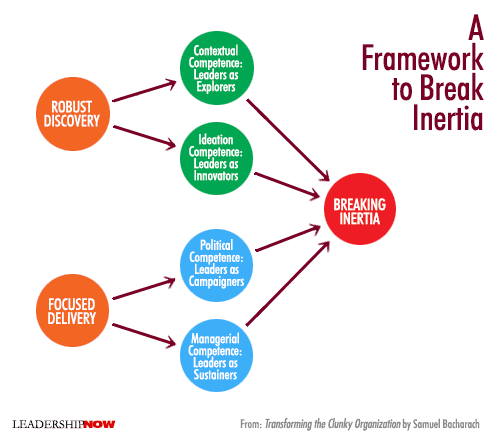 Robust Discovery To assure robust discovery, leaders must master the contextual competence of explorers and the ideational competence of innovators. To explore, they must scan the environment for useful information, read signals, and create partnerships. … Leaders who are innovators take steps to move an idea to germination. As an explorer, a leader looks for signals that the organization needs to adjust or to move in a new direction. Leaders should not just be scanning the familiar sources, but should also diversify the content they consume on a daily basis. If not, the tendency is to simply reinforce what we think we already know. Some signals need to be acted on immediately, others need to be thought through. “A strong signal elicits a question: What needs to be done? The weak signal asks, What does this mean?” Then those signals need to be transformed into an agenda. If you can see where a change needs to be made but can’t translate that into an actionable concrete agenda, a leader can actually drive their organizations into sluggish territory. Focused Delivery To assure focused delivery, pragmatic leaders must master the political competence of campaigners and the managerial competence of sustainers. …To engage in focused delivery, leaders must have the political competence to overcome the headwinds of resistance that sabotage forward movement and have the managerial competence to overcome challenges that could lead to dropping the ball. The important second half of the solution to breaking inertia in your organization is implementing the new agenda and seeing it through to get the desired result. “Leaders in sluggish organizations may have impeccable discovery, but they may stumble when it comes to making those good ideas a reality.” And then there’s the resistance. Ideas themselves are rarely threats. But “the moment that a specific idea shows concrete potential, the forces of resistance jump into action.” A leader must know where other people are coming from. “In clunky organizations issues of turf, transaction costs, and fear of losing power can lead to resistance. When the myopic tendency is in play, the fear of losing face or the security that comes from habit will cause many leaders to retreat into accepted business models and the old ways of doing things to preserve some semblance of safety.” It’s a fact that old game-changing agendas can become the new organizational pattern leading to inertia—the sluggish, myopic organization. Leaders must always be willing to seek out signals that old agendas need to be changed to regain organizational momentum. 
Posted by Michael McKinney at 08:30 AM
08.16.18

Straight Talk for Startups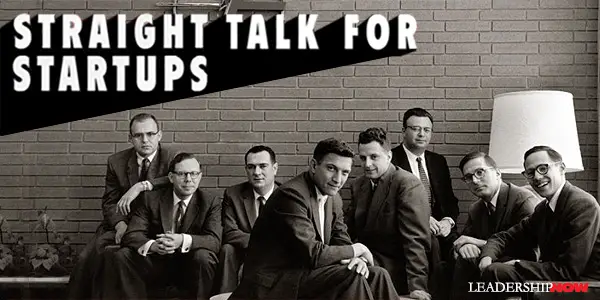
E Randy Komisar and Jantoon Reigersman bring decades of startup experience to help you beat the odds. In Straight Talk for Startups they offer 100 insider rules to bring clarity and a dose of reality to the entrepreneurial process. So whether you’re thinking of starting a business or are in the middle of managing one, this book will help to avoid (are correct) rookie mistakes. Komisar and Reigersman begin by telling you what matters and what doesn’t. Before you quit your job, here are a few things you need to think about: It’s hard. Because money is abundant, “it’s no surprise that the competitive landscape becomes crowded and non-economic.” It’s not uncommon for your competition to sell below cost in order to buy customers with their capital. And employees tend to act more like mercenaries than comrades in arms. Try to act normal. “There is nothing normal about being an entrepreneur.” I loved this line: “Venture capitalists have one of the greatest jobs in the world. They get to sit across the table from passionate strangers who hallucinate the future for them.” They advise that when selling your idea: “Don’t let them know you are one of those precious lunatics hell-bent on changing the world until you’ve gotten to know them better. You don’t want to scare them off right at the start.” Aim for an order-of-magnitude improvement. You’ve got to give people a really good reason to move from where they are quite comfortable to where you want them to be—a loyal customer. An order-of-magnitude of ten times is the minimum. Beyond that you improve your odds of success. “If you try to thread the needle with an innovation that is just good enough, you may miss [the target] entirely. But if you shoot for an order-of-magnitude change, you may still be in the game even if you miss by half.” Most failure result from poor execution, not unsuccessful innovation. “Plenty of people confuse luck for skill. We flatter ourselves and find cause where there is none. The difference between skill and chance boils down to repeatability.” Timing matters. The elements need to line up. The authors identify six significant stages of development: Stage 1: Idea—develop your idea and assess its attractiveness
There is a method to the madness. Don’t get ahead of yourself. Great clarification: “The creative process is essentially an execution process, not a eureka moment.” Other rules include:
Komisar and Reigersman close by saying, Always ask why. Why this? Why you? Why now? Asking why will keep you grounded. Know why this venture is important to you. Why it should be important to others. And given the low probability of success for any venture, why it is nevertheless worth failing at. Of course you don’t want to fail; success is always preferable to failure. But if you fail, will you feel you wasted your time, or that you fought the good fight? If you are considering starting a business, you will do well to also read Randy Komisar’s The Monk and the Riddle: The Art of Creating a Life While Making a Living. 
Posted by Michael McKinney at 08:01 AM
08.14.18

Leap: How to Thrive in a World Where Everything Can Be Copied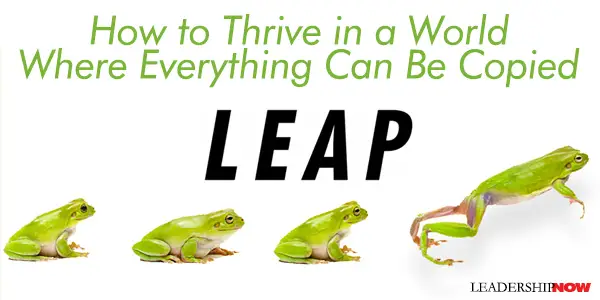
I Howard Yu explains in Leap: How to Thrive in a World Where Everything Can Be Copied, how a business can shield itself from copycats. (The stories are absorbing and alone are worth the price of the book.)
Principle 1: Understand your firm’s foundational knowledge and its trajectory
What is the core knowledge discipline that is most fundamental to your company and how widely available is it? Principle 2: Acquire and cultivate new knowledge disciplines
Two forces—the unwillingness to cannibalize current sales and the tendency to leverage what we have today—leads firms to give their advantage away to copycats. As P&G chairman William Cooper Proctor said in 1933, “This [synthetic detergent] may ruin the soap business. But if anybody is going to ruin the soap business it had better be Procter & Gamble.” When making the leap timing is important. Steve Jobs said, “Things happen fairly slowly.” Yu writes, “This is an important lesson. Successful executives often exhibit a bias for action. But it’s even more important to separate the noise from the signal that actually pinpoints the glacial movement around us. Listening carefully to the right signals requires patience and discipline.” Principle 3: Leverage seismic shifts
Principle 4: Experiment to gain evidence
Ask: “What world am I living in? What are the biggest trends in this world? How do I align my company’s activities so my organization gets the most out of these trends and cushions the worst?” And while experimentation is good, at some point someone has to pull the trigger. Stop the experimentation process and fully commit to an execution strategy. There is an abundance of ideas but not enough execution. Principle 5: Dive deep into execution
Looking at the successes and failures of startups, the difference “was not that the successful startups got it right the first time but that they learned from their mistakes early enough to shift gears. They had just enough money left over to restart after getting it wrong.” How do you thrive in a world where everything can be copied? You change the rules of the game. You leap from one knowledge discipline to another. “It turns out that regardless of the industry, it is possible to radically rewrite the rules of the game so as to demand a whole new field of knowledge in support of the change.” We can’t stand on what got us here, we must innovate. 
Posted by Michael McKinney at 07:44 AM
08.03.18

The Communication Secrets to Get from Good to Great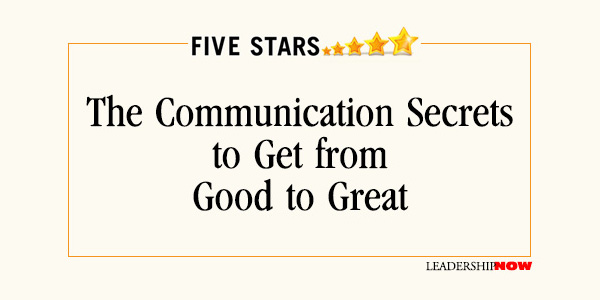
N The thing to keep in mind is that machines are machines and we are human. And if you are reading this, that’s your advantage. Specifically, your edge if your ability to communicate in imaginative ways, in a way that develops empathy with your listeners. Your ability to persuade and tell a story. In Five Stars, Carmine Gallo states that “your ability to communicate persuasively is the single greatest skill that will set you apart in the next decade.” Here’s the problem: finding people with the ability to communicate clearly and persuasively are “notoriously hard to find.” Aristotle gave us the foundation of good communication skills. The purpose of good communication was to encourage both the speaker and the listener to flourish. To this end, the speaker had to articulate the theme of the argument and then prove that their argument is both solid and logical. But a good argument moves us not on logic alone, but it also requires, Ethos (trust, wisdom, goodwill, or the character of the speaker) and Pathos (emotional appeal). Dr. Paul Zak says, “A compelling story with an emotional trigger alters our brain chemistry, making us more trusting, understanding, and open to ideas.” Geoff Ralston, a partner at seed accelerator Y Combinator, told Gallo: “I have to tell a story that is compelling enough for you to be a part of my story because I’ve created a change, something new and something interesting. And that narrative is something I want you to be a part of. That is how humans have created our civilization.” Gallo gives us example after example of how men and women have moved us through storytelling, by weaving a theme with logic, wisdom, and emotion. People like Neil deGrasse Tyson, Katelyn Gleason, Richard Branson, Richard Turere, Bryan Stevenson, and a host of others. Here are some takeaways: “Communication is more important than ever because we’re asking physicists, social scientists, biologists, to work together. In the past, they would work alone on individual projects and keep to their own discipline. –Anders Sahlman In 2012 Google began a three-year study called Project Aristotle to identify the habits of the most effective teams. They found that who was on the team matted less than how the team members interacted with each other. “Many meetings at Google now start with sharing stories and experiences—the emotional component of team building that bonds people together.” Next Gallo turns his attention to how we get from good or average to great—five star—communicators. He provides many ideas and examples but here are some key thoughts: Stories build an emotional connection with your audience. Create a signature story—a story unique to you and your brand. Brad Stone believes that “today’s upstarts have a critical skill that separates them from the previous generation of entrepreneurs—they can tell better stories.” Stories should be structured in three parts: The set-up (the trigger), the conflict (when all seems lost), and the resolution. Include details, a surprise, and empathetic characters. Stick to simple words and phrases. Think eight-grade readability. Simple takes a lot of work. “Great communicators make their work look effortless because they put a lot of effort into making it work.” Use analogies and metaphors. “To be a master of metaphor is the greatest thing by far…it is also a sign of genius,” wrote Aristotle. A former speechwriter to Bill Clinton, John Pollack wrote, “In many arguments, whoever has the best analogy wins.” Gallo says, “Persuasion cannot exist in the absence of analogy. Analogies force people out of conventional thinking. When an idea or a concept is truly different from what comes before, unconventional thinking is required to sell it.” Connect ideas from everywhere. Creative geniuses are not geniuses “because they are smarter; they are geniuses because they’re open to connecting ideas from different fields.” Gallo also covers how to deal with the fear of public speaking. “Neuroscientists have identified two techniques that will help you shine when the pressure is on: reappraisal and repetition. Reappraisal simply means reframing the way you think about yourself and the events in your life. Turning thoughts from negative to positive is the key to winning. Once you’ve transformed your thoughts, you have to put in practice time. Repeating a presentation over and over will boost your confidence for the big day.” There is so much in this book that will help you perform better in all of your communication. If only read one book on communication this year, read Five Stars by Carmine Gallo. 
Posted by Michael McKinney at 10:58 AM
08.01.18

First Look: Leadership Books for August 2018Here's a look at some of the best leadership books to be released in August 2018. Don't miss out on other great new and future releases.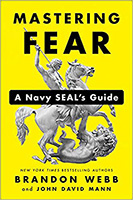 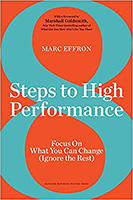 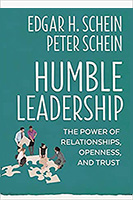 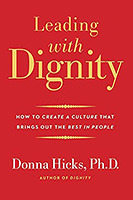 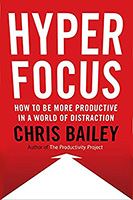
For bulk orders call 1-626-441-2024  Build your leadership library with these specials on over 39 titles. All titles are at least 40% off the list price and are available only in limited quantities. "A personal bookshelf is critical to developing the ability to inspire others in the pursuit of worthy goals." — Ret. U.S. Navy admiral James Stavridis, in Five Stars
Posted by Michael McKinney at 07:30 AM
|
BUILD YOUR KNOWLEDGE


How to Do Your Start-Up Right STRAIGHT TALK FOR START-UPS 
Grow Your Leadership Skills NEW AND UPCOMING LEADERSHIP BOOKS 
Leadership Minute BITE-SIZE CONCEPTS YOU CAN CHEW ON 
Classic Leadership Books BOOKS TO READ BEFORE YOU LEAD |
|